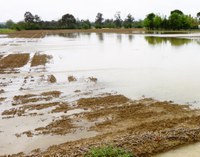NDSU analyzer helps with prevented-planting decisions
(Click the image below to view a high-resolution image that can be downloaded)
North Dakota State University Extension has developed a spreadsheet to help farmers analyze and make prevented-planting decisions.
“Producers in North Dakota are waiting for fields to dry out so they can start field work and crop planting,” says Ron Haugen, NDSU Extension farm management specialist. “If wet conditions continue in certain areas of the state, it will prevent some producers from seeding all their acres before the dates that crop insurance coverage starts to decrease. Now may be a good time to evaluate the economics of prevented planting, so a decision can be made if weather events delay planting to the crop insurance final planting date.”
After the final planting date, and if several eligibility requirements are met, producers may opt to collect a prevented-planting crop insurance indemnity payment and idle the ground, Haugen adds.
In North Dakota, the final planting date for full crop insurance coverage varies by crop and geographic location. For example, canola varies from May 15 in the southwestern part of the state to June 5 in the northeastern area of the state. For wheat, durum and barley, the date is May 31, except for the northern one-third of the state, where it is June 5. It is June 10 for soybeans, dry edible beans and flax. Sunflower final dates are June 10 in the northern counties and June 15 in the majority of the state.
The question is whether to plant a crop late and accept the risk of lower yields and reduced crop insurance coverage or to collect a prevented-planting indemnity payment.
The analyzer program uses partial budgeting to compare the economics of prevented planting with either late planting the crop for which a prevented-planting payment could be received or planting some other crop.
The prevented-planting indemnity is offset partially by the direct costs, such as cover crop seed, chemicals and fuel, to maintain the land that will not be used for crop production in 2023. This is compared with the income that could be obtained from growing a crop after the direct costs of production have been subtracted.
Two critical assumptions are the expected yield and market price for later seeding. Producers run the risk of lower yields and quality. The analysis also considers crop insurance indemnities, which may be received if a producer plants the crop late and yields suffer.
“The crop insurance coverage level is reduced for the first several days after the date when producers can choose prevented planting,” says Haugen. “Therefore, if a producer still can plant a few days late, they still can have a fairly strong safety net and have the upside revenue potential if better than expected yields and market prices exist.”
There are other considerations in the prevented-planting decision. Planting will use up soil moisture and lessen the possibility the ground will be too wet for seeding next year. Another reason to plant may be to satisfy a forward sales contract. However, late planting may result in lower yields and lower the actual production history, which is used to calculate future crop insurance guarantees.
The Excel spreadsheet tool is available to help with the prevented-planting decision. The spreadsheet also includes other prevented-planting information on eligibility and final planting dates.
The decision tool is located at ndsu.ag/preventplanttool.
Contact your crop insurance agent for more specific information and eligibility requirements. Each producer should analyze the prevented-planting option and consult with their crop insurance agent if unsure whether the acreage qualifies, what the payment rates may be and other details.
NDSU Agriculture Communication – April 28, 2023
Source: Ron Haugen, 701-231-8103, ronald.haugen@ndsu.edu
Editor: Kelli Anderson, 701-231-6136, kelli.c.anderson@ndsu.edu


